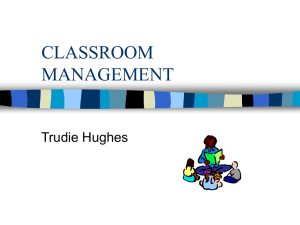Reinforcement in ABA for Educators: A Guide
advertisement
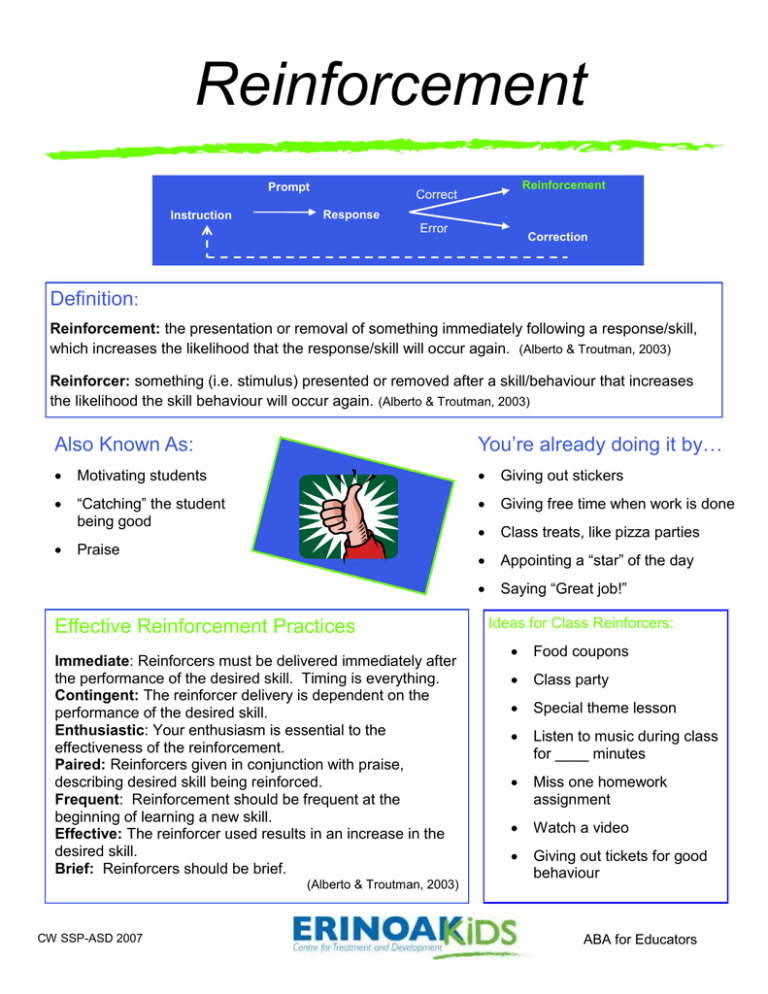
Reinforcement Prompt Instruction Reinforcement Correct Response Error Correction Definition: Reinforcement: the presentation or removal of something immediately following a response/skill, which increases the likelihood that the response/skill will occur again. (Alberto & Troutman, 2003) Reinforcer: something (i.e. stimulus) presented or removed after a skill/behaviour that increases the likelihood the skill behaviour will occur again. (Alberto & Troutman, 2003) Also Known As: You’re already doing it by… Motivating students Giving out stickers “Catching” the student being good Giving free time when work is done Class treats, like pizza parties Praise Appointing a “star” of the day Saying “Great job!” Effective Reinforcement Practices Immediate: Reinforcers must be delivered immediately after the performance of the desired skill. Timing is everything. Contingent: The reinforcer delivery is dependent on the performance of the desired skill. Enthusiastic: Your enthusiasm is essential to the effectiveness of the reinforcement. Paired: Reinforcers given in conjunction with praise, describing desired skill being reinforced. Frequent: Reinforcement should be frequent at the beginning of learning a new skill. Effective: The reinforcer used results in an increase in the desired skill. Brief: Reinforcers should be brief. (Alberto & Troutman, 2003) CW SSP-ASD 2007 Ideas for Class Reinforcers: Food coupons Class party Special theme lesson Listen to music during class for ____ minutes Miss one homework assignment Watch a video Giving out tickets for good behaviour ABA for Educators PAGE 2 REINFORCEMENT ABA FOR EDUCATORS Consider this when trying to reinforce... When giving a tangible reinforcer, pair it with social praise. Select and define the skill/behaviour to increase. Develop a menu of items/activities that the student likes. Use special interests to motivate the student/class. Offer choices (variety is the spice of life). Monitor effectiveness of reinforcers. Reinforcers should be gradually faded. Label the skill/behaviour being reinforced. Reinforcers are different for everyone. What is reinforcing on one day may not be on another. Reinforcers should not be available freely. Frequency of reinforcement should be gradually reduced to avoid dependency. Something is only reinforcing if it follows a skill/behaviour. Telling a student “finish your work or you will not get recess” is not a reinforcer. It is a threat. Token Economies A token system is a strategy where students earn “points” or “tokens” These points or tokens are then exchanged for a reinforcer. If using a token economy, you need to: 1. Teach the student that the token/point has value (i.e. you need to pair the token with the reinforcer). For example, if Sam is reinforced by stickers, then initially you need to give Sam a sticker and token together. 2. Teach the student that the token/point can be exchanged for the reinforcer. For example, if Sam is earning tokens to get stickers, and your goal is to have Sam earn 5 tokens before before accessing his reinforcer, initially you would start with Sam needing to earn only 1 token/point to get access to his reinforcer. Once he was earning the token reliably, you would increase the expectation so that he would need to earn 2 tokens before getting stickers, and so on until he was earning all 5 tokens. (Alberto & Troutman, 2003) Remember… Many typically developing students are internally motivated to learn new skills/activities or can be motivated by such things as praise and achieving good grades. Students with Autism Spectrum Disorders (ASD) may not be motivated in the same manner. In order to facilitate and promote their learning it is important to determine what is motivating for them. References: Alberto, A.A., & Troutman, A.C. (2003). Applied behavior analysis for teachers. (6th edition). NJ: Merrill Prentice Hall. ABA FOR EDUCATORS REINFORCEMENT PAGE 3 F.A.Q. How does reinforcement work in my integrated class? Teachers are often concerned about the fairness of providing one student with more reinforcement than the others. One way to view this is to remember that fair does not mean equal- fairness means everyone gets what they need to succeed. In order to be successful, students with ASD typically require reinforcement. Having the entire class work towards a special treat, or implementing a class wide token system can also be an effective way to motivate all students in your class. I always praise my student but he still hasn’t learned how to spell his name. Since verbal praise is motivating to most students we often assume it will be equally reinforcing for our students with ASD. Instead, try creating a menu of items or activities that (s)he can choose to work for. Also, when beginning to teach a new skill, it may be necessary to reinforce more frequently for small successes, such as picking up the pencil, putting the pencil to paper, etc. Nothing motivates my student. Some students with ASD have unique interests which may not be obvious. It may be necessary to gather information about preferences by talking to parents, former educators and support staff. Talking to the student or watching him/her during free time will also provide you with additional information about preferred activities/items. When gathering information, keep in mind the following four types of reinforcers: Tangible reinforcers (consumables, small objects), Activity reinforcers (preferred events, listening to a CD), Social reinforcers (praise, attention), and Sensory reinforcers (sand, music). Types of Reinforcers include: Tangible Activity Social Sensory Isn’t using reinforcement to strengthen a skill/behaviour the same as bribery? The difference between reinforcement and bribery is that reinforcement comes after a task is completed where as bribery is offered before. Also, in bribery we can be looking at both increasing and decreasing a behaviour/skill dependent on the bribe; however, in reinforcement we are solely looking at the increase. When you ________________we will punch your card. When your card has 12 holes punched out, you will earn __________________.
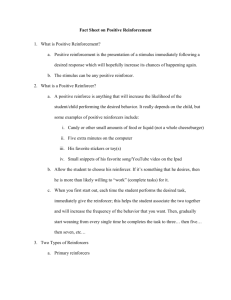
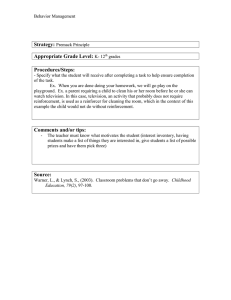
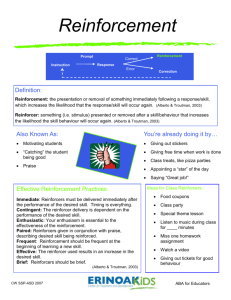
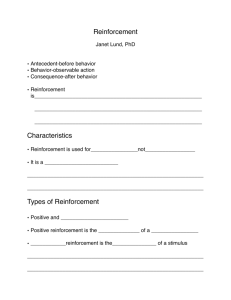

![Reinforcement and Motivation [Compatibility Mode]](http://s3.studylib.net/store/data/008925113_1-f5c766bb58c7f58b529c7a2527652f66-300x300.png)
